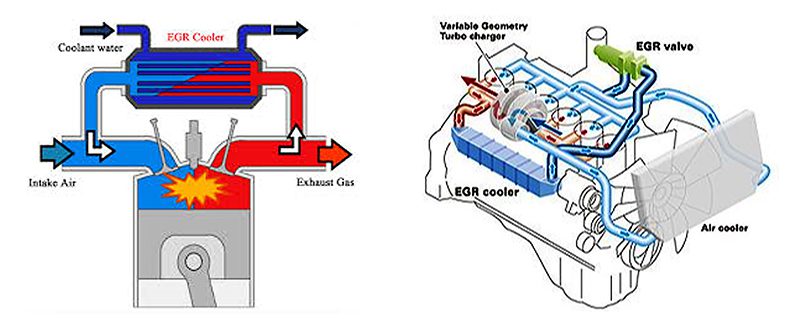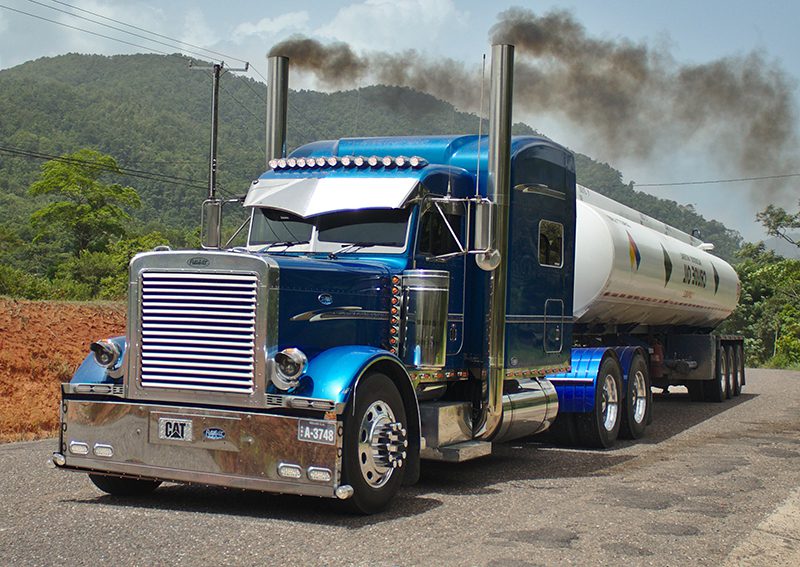EGR system on the sump
EGR system on the sump – With a view to reducing the levels of nitrogen oxides (NOx), compounds to which some respiratory diseases and types of cancer are attributed and present in the exhaust gases of internal combustion engines Diesel Cycle 4T of mobile equipment in the agricultural area and civil construction, in order to meet the requirements of emission control standards demanded by government agencies such as US EPA Tier 3/Tier 4 ( USA ), Stage II/IIIA (European Union) and PROCONVE MAR-1 ( Brazil ), the OEMs have introduced some technical innovations in the projects of the aforementioned equipment, such as:
-
-
- Change in fuel injection time delay (Ultra-Low Sulfur Diesel in usa; B S10 in Brazil );
Elevation in the position of the segment rings on the skirts and piston heads; - Use of the scr exhaust gas aftertreatment system (Selective Catalytic Reduction) – Selective Catalytic Reduction and DPF (Diesel Particulate Filter) – Diesel Particulate Filter;
- Use of the Introduction of the Exhaust Gas Recirculation (EGR) exhaust gas aftertreatment system;
- Change in fuel injection time delay (Ultra-Low Sulfur Diesel in usa; B S10 in Brazil );
-
 Some projects of internal combustion engines Ciclo Diesel 4T of mobile equipment in the agricultural area and civil construction have started to use the gas aftertreatment system of exhaust gas recirculation (EGR) with the intention of controlling NOx emissions (nitrogen oxides) by returning to the combustion chamber part of the air + fuel mixture ( Ultra-Low Sulfur Diesel in the USA; B S10 in Brazil ) that goes into combustion in order to reduce the combustion temperature of the mixture that will enter compression ignition and reduce, through this mechanism, the formation of NOx (nitrogen oxides) and satisfy government regulations.
Some projects of internal combustion engines Ciclo Diesel 4T of mobile equipment in the agricultural area and civil construction have started to use the gas aftertreatment system of exhaust gas recirculation (EGR) with the intention of controlling NOx emissions (nitrogen oxides) by returning to the combustion chamber part of the air + fuel mixture ( Ultra-Low Sulfur Diesel in the USA; B S10 in Brazil ) that goes into combustion in order to reduce the combustion temperature of the mixture that will enter compression ignition and reduce, through this mechanism, the formation of NOx (nitrogen oxides) and satisfy government regulations.
Click on the image below and read the complete article “The impact of the EGR aftertreatment system on the sump lubricating oil” in the digital version of the magazine “LUBES EM FOCO – issue 86” :
 Part of the volume of exhaust gases that have already been ignited will be reintroduced into the combustion chamber, displace oxygen (O2), reduce the temperature in the combustion chamber and thus be generated less NOx (nitrogen oxides).
Part of the volume of exhaust gases that have already been ignited will be reintroduced into the combustion chamber, displace oxygen (O2), reduce the temperature in the combustion chamber and thus be generated less NOx (nitrogen oxides).
However, this process has a price: part of the contaminants that would be expelled by the exhaust collector will be returned to the combustion chamber and will cause increased contamination of the lubricating oil from the sump.
Exhaust Gas Recirculation (EGR) internal combustion engines of mobile equipment, by using the Exhaust Gas Recirculation (EGR) exhaust gas aftertreatment system can expose the lubricating oil of the sump to a higher level of contamination, the faster degradation of the condition in service and the increased wear of the relative moving parts due to the increase in lubricating oil of:
-
-
- Abrasive solid particulate matter (e.g. soot; unfiltered silica);
- Acid compounds derived from fuel combustion (Ultra-Low Sulfur Diesel; B S10 ) and thermo-oxidation of lubricating oil (e.g. H2SO4);
- Hydrocarbons (HC) that have not combusted.
-
Another worrying issue is the effect that the Exhaust Gas Recirculation (EGR) exhaust gas aftertreatment system may have on the durability of the Diesel Cycle 4T internal combustion engines of mobile agricultural equipment and construction and the lubricating oil of the sump.
It has been verified that lubricating oils in internal combustion engines Diesel Cycle 4T of mobile equipment agricultural area and civil construction equipped with exhaust gas gas recirculation system (AN), sharp increase in Kinematic Viscosity and more significant reduction in Basic Number (BN) in view of greater exposure to acid/corrosive gases and accumulation of abrasive solid particulate matter of inorganic origin (e.g., unfiltered silica) and organic (e.g., soot).
In the cooled exhaust gas recirculation system (Cooled Exhaust Gas Recirculation), portion of the exhaust gas that will be reintroduced into the combustion chamber is cooled, before reinsertion, by the cooling system of the internal combustion engine Diesel Cycle 4T.
As the coolant transports the heat from the exhaust gases, the temperature of the cooling system will be higher in internal combustion engines Ciclo Diesel 4T equipped with cold exhaust gas recirculation system (Cooled Exhaust Gas Recirculation) and, as a result, the temperature of the lube oil of the sump will be higher.

By the rule of Arrhenius, the speed of a chemical reaction doubles with each increase of 10 °C. Therefore, it can be assumed that the life of a lubricating oil will be halved every 10 °C of increase in the service temperature. Considering that in internal combustion engines Ciclo Diesel 4T equipped with exhaust gas aftertreatment system of type COOLED EGR (Cooled Exhaust Gas Recirculation) the service temperature of the lubricating oil of the sump may be, on average, 4ºC to 5ºC higher, the thermooxidative degradation tends to be more severe and require greater resistance to oxidation of the lubricating oil to be used.






















